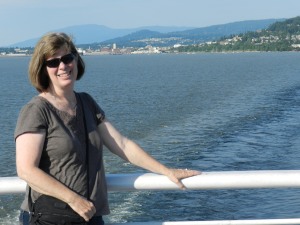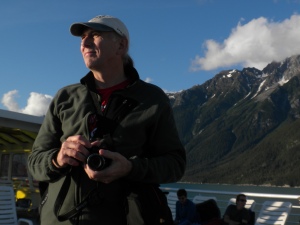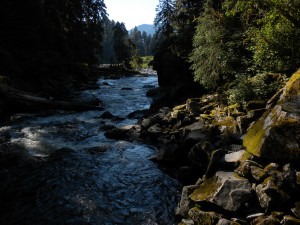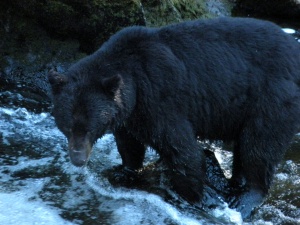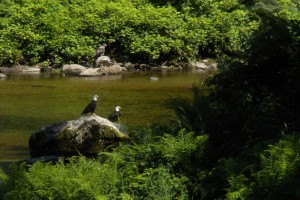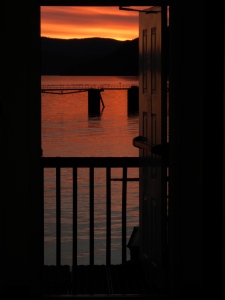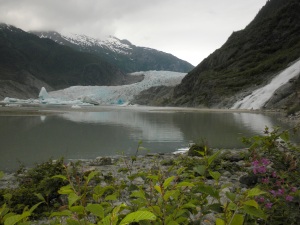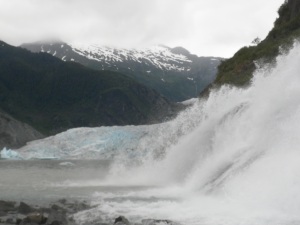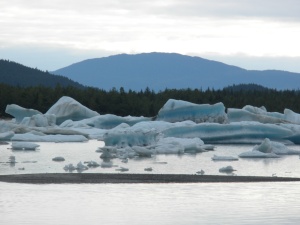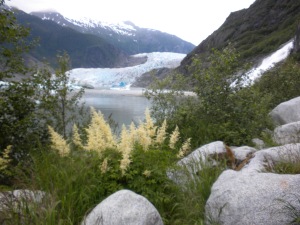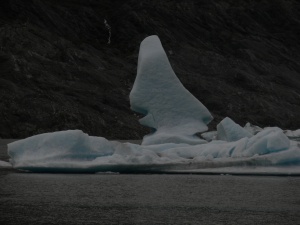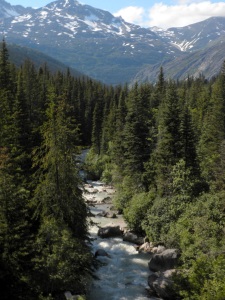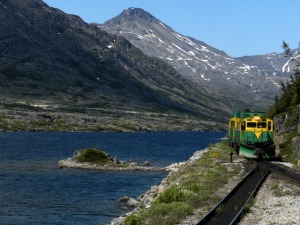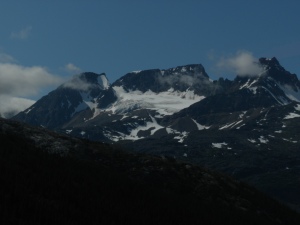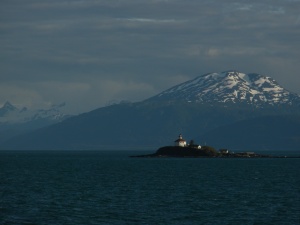When do they sleep?
I began this blog talking about the challenge behind renting a car in Wrangell. In that first and second posting, I reflected on the “Practical Rental Car” company and how it was only open for an hour or so in the morning and an hour or so in the afternoon when the planes come in. What do the employees do with the rest of their time? I wondered. Hunt? Fish? Write?
The answer? They work other jobs—several of them. Betsy, the one who took our reservation, also worked the front desk of the Stikine Inn where we stayed. The other rental car employee, Kathleen, had two other jobs—one of which was being the weather reporter for the island. As I mentioned earlier, she only told you what the weather was doing in the moment, probably most useful for pilots coming into the airport—but no predictions.
That’s how it is in Wrangell…and in most of small town Alaska. What you see is what you get. Our waitress at the Inn, Lisa, not only waited tables, she made the lattes, bussed the tables and washed down the deck afterwards. She was also “the town painter,” she told us. Last summer, she painted the exterior of the Inn.
Alaskans do what they do to survive, and that usually means working their butts off. I mean, these are rugged, independent, hard-working people. The question is no longer, “What do they do with the rest of their time?” It’s, “When do they sleep?” I came away with a hearty respect for anyone trying to make a living there.
Well, that’s it. Thanks for joining me on the journey. Doing a blog in the wilderness was a little crazy-making, but I’m generally glad I did it!
Happy trails,
Mary … and Richard, too
The Gang
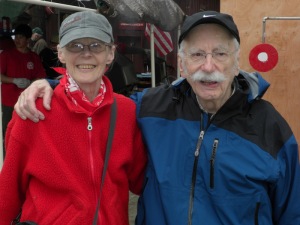 As I put this blog to “bed,” I wanted to be sure to give a grateful nod to our traveling companions through this Alaskan journey. Donna is Richard’s cousin and Floyd, our cousin by marriage. Despite the difference in our ages, we found it hard to keep up with them! One of our favorite memories is our group readings of scenes from the play, “On Golden Pond,” when we were staying in Juneau. Floyd had played Norman recently in a production in Redmond, Washington, and he gave us a taste of his brilliant performance—one that had garnered him a standing ovation on the last night of its run.
As I put this blog to “bed,” I wanted to be sure to give a grateful nod to our traveling companions through this Alaskan journey. Donna is Richard’s cousin and Floyd, our cousin by marriage. Despite the difference in our ages, we found it hard to keep up with them! One of our favorite memories is our group readings of scenes from the play, “On Golden Pond,” when we were staying in Juneau. Floyd had played Norman recently in a production in Redmond, Washington, and he gave us a taste of his brilliant performance—one that had garnered him a standing ovation on the last night of its run.
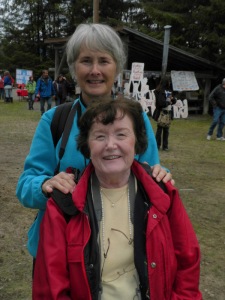 Terri and Marty are retired nurses and were absolute “hoots” on the marine highway—so kind, so curious, so companionable. Richard and I are pleased to have made these two new friends.
Terri and Marty are retired nurses and were absolute “hoots” on the marine highway—so kind, so curious, so companionable. Richard and I are pleased to have made these two new friends.
Eagles and Bears, Oh My!
 July 12th: Finally, our bear tour! We all believed that this would be the grand culmination of our Alaska adventure and we were not disappointed. It was the most beautiful, clear, sunny day yet. Wrangell natives were saying it was the best day of the year, weather wise. We have discovered that here in Alaska, weather is just about EVERYTHING. Rain and fog…and you wind up seeing nothing. Our tour leader said that just two days or so before we got there he had had to cancel that day’s bear tour because the level of the stream was so high the bears couldn’t get to the bank to fish. And so, we counted our blessings on our “perfect day.”
July 12th: Finally, our bear tour! We all believed that this would be the grand culmination of our Alaska adventure and we were not disappointed. It was the most beautiful, clear, sunny day yet. Wrangell natives were saying it was the best day of the year, weather wise. We have discovered that here in Alaska, weather is just about EVERYTHING. Rain and fog…and you wind up seeing nothing. Our tour leader said that just two days or so before we got there he had had to cancel that day’s bear tour because the level of the stream was so high the bears couldn’t get to the bank to fish. And so, we counted our blessings on our “perfect day.”

After an hour ride in a high speed, river runner boat, we arrived at the Anan Bear Observatory on the mainland across from Wrangell Island. It was a half mile walk to the viewing deck. Our group of about a dozen folks followed closely behind our guide–the man with the gun. We didn’t see a bear on the path as many groups before us had, but we did see “signs” of bear all around! (The next morning I would awake with the thought….”Oh…so that’s where that phrase comes from…Does a bear sh–t in the woods?…because there is a whole lot of it everywhere you walk!)
 Upon arrival at the multi-tiered observation deck, the bears began to emerge from their caves in the rocks by the stream as if on cue…and up above eagles–both mature and immature–flew right by us, landing on trees and fallen trunks. Honestly, there was so much activity for the three hours we were there, we didn’t know where to look next.
Upon arrival at the multi-tiered observation deck, the bears began to emerge from their caves in the rocks by the stream as if on cue…and up above eagles–both mature and immature–flew right by us, landing on trees and fallen trunks. Honestly, there was so much activity for the three hours we were there, we didn’t know where to look next.
Enjoy the pictures! I’ll be posting one more time as a follow-up reflection in a few days. Richard and I made it back to civilization last night and are on our way to Whidbey Island today (July 14) to visit friends. In five days, we will return to our family’s house in Sedro-Woolley for a week’s visit. Stay tuned!
Hanging out in Wrangell
 July 11th: On this day, we rented a van from “Practical Rental Car” at Wrangell’s airport and drove around the island. We never did meet Betsy, but Kathleen took care of us this morning. Besides her job with the rental car company, she works “upstairs” reporting on the weather in Wrangell. She says she offers no predictions–just what the weather is doing at the moment. She glances out her window. “Today, it’s sunny,” she says and laughs.
July 11th: On this day, we rented a van from “Practical Rental Car” at Wrangell’s airport and drove around the island. We never did meet Betsy, but Kathleen took care of us this morning. Besides her job with the rental car company, she works “upstairs” reporting on the weather in Wrangell. She says she offers no predictions–just what the weather is doing at the moment. She glances out her window. “Today, it’s sunny,” she says and laughs.
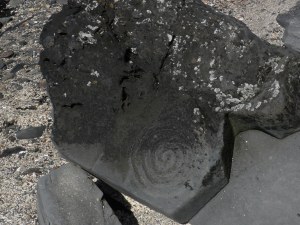
PETROGLYPH BEACH: Our first stop was Petroglyph Beach where an ancient people preceding the Tlinget native population carved images onto rock perhaps 10,000 years ago. I was particularly intrigued with the spiral petroglyphs, knowing that Carl Jung has identified that image as an archetype that crosses cultures. Indeed, this petroglyph image has shown up in Mexico and Ireland as well as southeast Alaska and other places. Yet one more demonstration of how we are all connected.
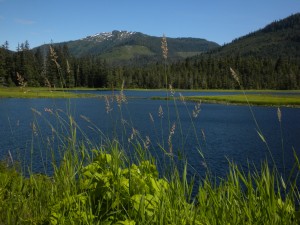
PAT’S LAKE: Our next stop after the beach was Pat’s Lake where we stopped the van, rolled down the window and watched the water sparkle and the wetland grass roll in gentle waves. A man walked down the road towards us, walking his Malemute dog by holding his bushy tail like you would a leash. He stopped to greet us and we struck up a conversation. He has lived in different places in the world, he said, but he always comes back to Wrangell. The last time he left was thirty years ago, so he guesses he’s probably here for good.

NEMO LOOP: At the end of the paved road just thirteen miles from town, we took a well maintained gravel road around the perimeter of the island, stopping to see the stunning views of mountains and water along the way. At one stop, we saw two mature eagles and their nest in which we detected the movement of their youngster. Later, we stopped at an overlook called “Three Sisters” where a picnic table of rollicking women regaled us with their bawdy humor. I think they were sisters, something akin to Medusas. Richard barely got out of there alive.
Back in town, we ate a wonderful dinner at the Stikine Inn where we were staying. Later, Richard and I watched the sunset out our bedroom window. At midnight, the moon was rising in the east while the sun was still lighting up the sky in the west. Truly, this is the land of the Midnight Sun.
Beauty Rush
July 8: Skagway, Alaska…gateway to the Yukon Gold Rush. Floyd, Donna, Terri, Marty, Richard and I got on the White Pass train with a whole lot of other people and headed up the mountain, retracing the trail that over thirty thousand people attempted to traverse in their hunt for gold.
Our shuttle driver the day before told us about his first time on the train. White Pass was covered in mist, he said, and he didn’t see a darn thing. That’s the thing about Alaska. Some days, its beauty is in-your-face; other days, it throws up a veil of rain or fog or mist, and you have to look a little harder. On this day, however, the sun was shining and the views were stunning.
Saturated in Beauty
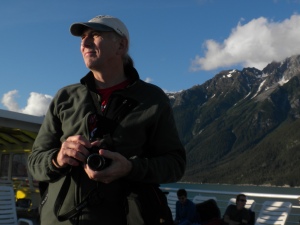 On July 8, we boarded the ferry once again, this time for a six-hour trip up the Lynn Canal from Juneau to Skagway, by far the most beautiful ferry trek on our journey yet. Skagway was one of the gateways to the Yukon Gold Rush back in the late 1800s when “the rich were getting richer, and the poor were getting poorer” and people were feeling desperate. Sound familiar? Anyway, the beauty of this channel was breathtaking. The undulating green mountains were not on some distant horizon, but came right to the water’s edge. No longer shrouded in mist, they stood grand and imposing. We couldn’t take our eyes off them. After hours of mountain gazing, I felt saturated in their beauty and needed to go into the cabin and rest.
On July 8, we boarded the ferry once again, this time for a six-hour trip up the Lynn Canal from Juneau to Skagway, by far the most beautiful ferry trek on our journey yet. Skagway was one of the gateways to the Yukon Gold Rush back in the late 1800s when “the rich were getting richer, and the poor were getting poorer” and people were feeling desperate. Sound familiar? Anyway, the beauty of this channel was breathtaking. The undulating green mountains were not on some distant horizon, but came right to the water’s edge. No longer shrouded in mist, they stood grand and imposing. We couldn’t take our eyes off them. After hours of mountain gazing, I felt saturated in their beauty and needed to go into the cabin and rest.
Calibrating Our Compass
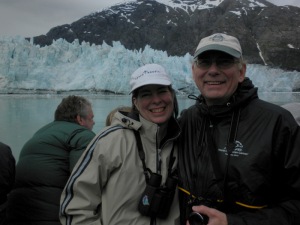 July 6: I will only be posting new entries every few days from now on. Although I enjoy these times of reflection, I’m finding this process a bit distracting from the journey—and the people—at hand. Add to this, the spottiness of the internet connections in what is mostly wilderness, and I’m getting the message I simply need to “be.”
July 6: I will only be posting new entries every few days from now on. Although I enjoy these times of reflection, I’m finding this process a bit distracting from the journey—and the people—at hand. Add to this, the spottiness of the internet connections in what is mostly wilderness, and I’m getting the message I simply need to “be.”
Ahhh….I feel better already. You cannot imagine the beauty that surrounds me as I write. In this moment, the ferry has stopped its forward movement and is turning on an invisible axis. The sun is shining, the water peaceful and glistening, mountains high, covered in mist. Honestly, I do not know why we are turning. I don’t know why we don’t seem to be going anywhere. And so, I have to wonder, what will happen next?
Later…still spinning, and guess what? According to the rumor circulating the cabin, the ferry’s compass was “off,” and now they have two compass experts on board, calibrating it. To do this, the boat must turn in place for what turns out to be approximately 45 minutes. Strange, but I have to say, we couldn’t be in a better place to spin. We’re just outside Juneau’s harbor and for the first time in days, the sun is out, bright and shining. Richard sets his camera on a mini-tripod and turns on the video, recording 360 degrees of our perfect circle. While we’re recording, we talk to a young woman who lives in Anchorage and works for the National Audubon Society as a landscape ecologist, mapping “hot spots” of wildlife diversity all over the country. She is doing good work in the world.
Back in the cabin, we rejoin our seatmates—a beautiful young couple with whom we’ve become instant friends. They are in a long distance relationship and are wondering where it’s going, where they are going. They spent their time as the ship turned, recalibrating their relationship compass as they pondered these questions. Richard and I shared our own experience of living 2500 miles apart for our first three and a half years. We hope it helped. Looking into their eyes, we could see a purity of spirit and yes, love.
“You’re going to be just fine,” I told them. “Give it time. Eventually you’ll know which direction you need to take.”
“Did one of you have to give up a lot?” the young man asked.
Yes, I told him, I guessed I was the one who gave up the most, leaving my community in Traverse City, Michigan and moving out to Seattle. But then I added, “In the giving up, I gained so much more.”
And so my friends, writing this has caused my own compass to re-calibrate. As much as I enjoy these reflections, I cannot promise you when the next one will be. I’ve decided that the journey-in-the-moment is my priority. Stay tuned, though. You never know what’s going to happen next.
The Imprint a Glacier Makes
July 5: As I write, a raven is squawking loudly, its raucous KAW KAW KAW echoing through the thick green of alder and spruce outside our lodge room window. We have just returned from our eight hour cruise up Glacier Bay in a heated, two-deck catamaran. The Margerie Glacier at the tip of the bay may have been our destination, but the journey from Bartlett Cove, there and back again, was equally spectacular.
The sky began overcast but the weather was dry when we cast off at seven-thirty in the morning. Right away, we saw puffins floating on the surface of the water—those lovely black-bodied, white-faced birds with the large, curved orange beaks, sporting tassels at the top of their heads. Then there were hump back whales, breaching at a distance, spouting spray over thirty feet in the air. As the already gorgeous scenery grew more spectacular by the moment, we began spotting even more wildlife: Sea lions basking on rocks, and on Marble Island, a wide range of sea birds including Cormorants, Terns, Gulls, Puffins, and Common Murres that nested there. Further up the bay, a brown (grizzly) bear walked along the rocks above an island shore. A white, fuzzy-bearded mountain goat stood so still between two patches of green on a rocky ledge that we thought he was stuffed, but then “she” moved, revealing a small baby goat lying at her feet.
After a few hours, we finally approached the glacier at the end of the “road,” so to speak. Having seen glaciers on National Geographic, we had expected to be bowled over by its massiveness towering above us, but surprisingly that wasn’t our first impression. A crystal blue and white wonder of nature, yes. More ice than we’ve seen in a lifetime, yes. But smaller in our view than what we expected. For safety, the boat stayed at least a half mile away, so getting an accurate perspective was challenging.
Emma, our park ranger for the day, told us it was a mile across and over 250 feet high. That’s really big, I thought, as we gazed at the sculptured beauty before us, half a mile away. “Imagine a twenty-five story office building a mile long,” Richard later said, as we tried to match the reality of what we saw with the meagerness of our perception. imagine the imprint this glacier has had on the vast landscape around it, Emma encouraged us to consider, including over sixty miles of bay created in the wake of the glacier’s retreat in only two hundred and fifty years—a relatively short period of time, geographically speaking.
Fact by fact, Emma tried to convey the enormity of the glaciers imprint upon us, but try as we might, our limited human sight simply could not grasp what intellectually, we were trying to understand.
And so, we stood on the upper deck, perhaps fifty strong, gazing in silence at the vast presence before us as it periodically cracked and groaned under its own weight. A minor piece of ice—at least it looked minor to us—broke or “calved” from the greater body and fell with a splash. We saw it before we heard it CRACK seconds later, proving that light travels faster than sound, and giving us a sense of the distance between it and us—but only a sense. None of it—not the facts, not the sight, not the sound, not even the wide angle lens of our camera—could give us the full measure of its presence in our midst.
On our way back to Glacier Bay Lodge, we saw two black wolves at the shoreline in two different sightings. One wolf lay next to a whale carcass that had washed ashore, as if those bones were all his. Emma had a gang of youth hanging around her most of the trip—budding junior rangers who were busy spotting wildlife and completing the activities in their ranger books while preparing for their “presentations” to the rest of us on the return back to the lodge. Near the end of our journey, Emma inducted around ten junior rangers, which had to be some kind of record. And then she went around handing out badges to the rest of us for our “enthusiasm” and “for asking good questions.” As we looked upon the seriousness of those youthful faces, we just knew these youngsters will be good stewards of the earth. They gave me hope that maybe, just maybe, the earth will survive the limits of our human understanding.
As our boat turned into Bartlett Cove at the end of our trip and right after the junior rangers had promised to honor and protect the environment and its wildlife, Emma invited us all to consider not only the imprint the glacier has made on the landscape, but also the imprint the glacier has made on us.
July 6th: It’s now the day after our glacier tour and I’m still considering that imprint as we head back to Juneau on the ferry. And to find that imprint, I’ve decided that I need to go to a deeper place than what only my five senses allow. Here’s what I’m wondering now: If we rely only on our senses—only on what can be seen or heard or measured by our limited perceptions—might we be missing something really important? Might we be missing the enormity of something that could save our lives?
Gustavus Rocks!
 July 4: We consider ourselves very fortunate to have experienced the Fourth of July in Gustavus, Alaska—a small town of around 350-400 people with a very big community heart. According to one local, it is their biggest party all year.
July 4: We consider ourselves very fortunate to have experienced the Fourth of July in Gustavus, Alaska—a small town of around 350-400 people with a very big community heart. According to one local, it is their biggest party all year.
Just a bit of background on the town: Considered the “gateway to Glacier Bay,” Gustavus has only one general store and a kind of “Costco” outlet, one restaurant (pizza), one gas station—one of the coolest I’ve ever seen with old fashioned pumps that really work, a fire station, a city hall, and a few other minor businesses. The Gustavus school has around 50 children, K-12. They just got ferry service this year. There’s no place to register cars on the island, so many license plates are out of date; we saw one dated as far back as 1995. Glacier Bay National Park is by far the largest “going concern” in the area, covering 3.3 million acres. We are staying at the Glacier Bay Lodge, although there are a few other inns and B&Bs in the area.
 Our hosts at the Lodge gave us a choice when they picked us up at the ferry: Come back to the Lodge or stay in town to enjoy the Fourth of July festivities. Even though we had been up since 3:30 that morning with a few grumpy hours (all mine; I’ll speak for myself) from about 5:30 to 7 am, our entire group felt a sudden surge of energy. Let’s stay! Since we hadn’t eaten lunch, some of us headed for the grilled burgers, while the rest headed for the homemade pies. “The best pie-maker in Gustavus” made the rhubarb which according to Richard, rivals the one his mother made. I’ve known him for eighteen years and this is the first time I’ve heard him rate a pie this high. Since when is anything as good as what one remembers from childhood?!
Our hosts at the Lodge gave us a choice when they picked us up at the ferry: Come back to the Lodge or stay in town to enjoy the Fourth of July festivities. Even though we had been up since 3:30 that morning with a few grumpy hours (all mine; I’ll speak for myself) from about 5:30 to 7 am, our entire group felt a sudden surge of energy. Let’s stay! Since we hadn’t eaten lunch, some of us headed for the grilled burgers, while the rest headed for the homemade pies. “The best pie-maker in Gustavus” made the rhubarb which according to Richard, rivals the one his mother made. I’ve known him for eighteen years and this is the first time I’ve heard him rate a pie this high. Since when is anything as good as what one remembers from childhood?!
After dessert, we watched a laid back game of horseshoes, a kind of “ski race” with teams of four trying to navigate a course on the same pair of “ski-boards,” a “slow” bike race across a wooden bridge (the last one across without touching their feet on the ground, wins); and an egg toss with something like twenty dozen eggs and most of the town participating out behind city hall. There were grown men in red, white and blue floppy top hats sporting tiny American flags and a dunking machine with a toilet on top. We didn’t actually see it in action, but we suspect there was some flushing involved.
Everywhere, the good humor was contagious. No one sang “God Bless America” and come to think of it, I don’t remember hearing a single firecracker or one firework, but I believe the community spirit we witnessed was more patriotic, more American, than…well…rhubarb pie.
